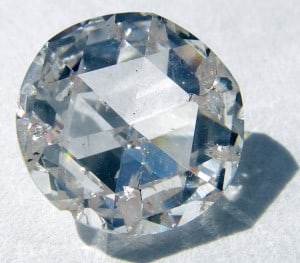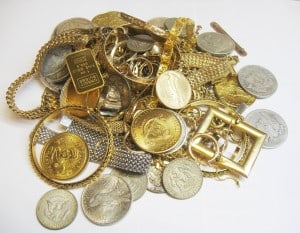The following post should concern you even if you are not a diamond miner, which we assume most of our readers are not. Even if the only diamond you ever own is in an engagement ring, there is trouble ahead.
At last year’s National Pawnbrokers Association convention, Martin Rapaport, publisher of the Rap Report guide to current diamond prices, spoke about the increasing appearance of synthetic diamonds and how difficult they are to tell from natural ones.
We are not talking only about artificial coloring of natural stones, which is impossuible to detect, but also about factory-made stones passing as dug-from-the-ground gems.
A year ago, Rapaport was saying that the problem was coming but was not yet a big problem for diamond buyers and sellers in pawn shops (and, by implication, for their customers). Well, trouble is here already.
As Bloomberg News reports, producers of natural gems are frightened enough to have, for the first time ever, formed an industry association:
The famously secretive diamond industry has lacked coordinated leadership since De Beers’s monopoly over the supply of gems ended after it lost a 10-year legal battle with the U.S. over price-fixing in 2004. The proposed association would represent the vast majority of the world’s diamond supply.
When we say that the value of a diamond is determined by the 4Cs (color, cut, clarity and carat-size), left unsaid is the fifth factor: rarity. Manufactured diamonds, of course, are potentially infinite in availability.
Diamonds have been made industrially since the 1950s, but the process was difficult, not too cheap and not well-suited to making gem diamonds. Technology advances.
Although a variety of factors have driven down the cost of genuine diamonds considerably (end of the deBeers control, new sources in Russia, South America and Africa outside South Africa), the cost of producing a look-alike has fallen even faster.
The Times of India reported last month that 110 manmade diamonds were discovered in a parcel in the Indian city of Surat, the world’s biggest cutting center. The undisclosed mixing of diamonds has been discovered on several occasions in the nation with India’s Gem Jewellery Export Promotion Council starting the Natural Diamond Monitoring Committee to combat the issue.
The fact that the unscrupulous traders were caught proves that it is still possible to tell the difference between manmade and natural diamonds, but is not easy, inexpensive or quick. (An artificially colored natural diamond is undetectable with current technology.)
It requires a specialized laboratory and days. At present, a retail buyer of stones, like our Maui pawn shop, cannot do the test, and the days required mean that customers are not likely to wait around for a distant lab to report. We can hope that the technology will improve and become cheaper, the way gene-splicing moved from custom work to mass production (to take one example from many). But who knows when that will come?
At present, there are not so many fake gem diamonds in circulation that pawn shops and jewelry stores are taking a big risk in making an offer for a customer’s old jewelry. But the incidence of fakes could accelerate rapidly.
Pawnbrokers have already seen how fake coins — made available in huge quantities from the world’s largest Internet scam business, Alibaba — have ruined the numismatic market for some coins, including Kingdom of Hawaii coins.
For the moment, Rapaport is sticking with the advice he gave his pawnbroker audience last year: Know who you are dealing with and stick with respectable vendors.
Addressing whether consumers should be concerned about diamond synthetics, Martin Rapaport said, “If you’re going to be buying diamonds, you better be dealing with a reputable source and that’s number one. There are a million ways for the consumer to be taken advantage of and it’s important for the consumer to buy from a reputable source even if it cost a little more.”
He also added, “Find someone you’re comfortable with and trust. Don’t feel you’re under pressure to buy. A lot of times you are under some pressure, you really want to get engaged, but I say relax and find the time to find someone that you trust. Comfort is king.”
#maui #mauiretail #mauijewelry







